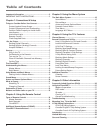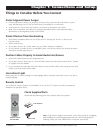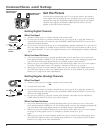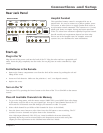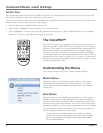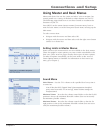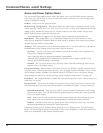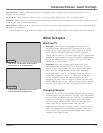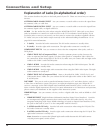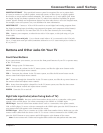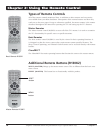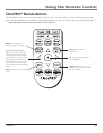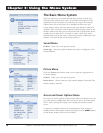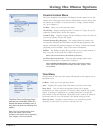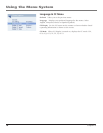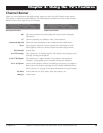
Connections and Setup
12 Chapter 1
Explanation of Jacks (in alphabetical order)
This section describes the jacks on the back panel of your TV. There are several ways to connect
devices.
ANTENNA/CABLE ANALOG INPUT Lets you connect a coaxial cable to receive the signal from
the antenna, cable, or cable box.
ANTENNA/CABLE DIGITAL INPUT Lets you connect a coaxial cable to receive the signal from
the antenna, digital cable, or digital cable box.
AUDIO Use the Audio Out jacks when using the MONITOR OUTPUT Video jack or use these
jacks by themselves to connect an audio receiver to the TV for enhanced sound quality. If you
use these jacks to receive your sound, you don't need to connect the speakers supplied with the
TV. Make sure you set the Audio output correctly in the Advanced Settings Sound menu. Go to
page 28 for more information.
• L (Audio) Provides left audio connection. The left audio connector is usually white.
• R (Audio) Provides right audio connection. The right audio connector is usually red.
COMPONENT INPUTS Lets you connect a device that has component video jacks, such as a
DVD player.
• CMP1 Y Pb/Cb Pr/Cr (Component Video) Provides optimum picture quality because the
video is separated into three signals. Use three video-grade or component video cables for
the connection. When using CMP1 Y Pb/Cb Pr/Cr, make sure you connect left and right audio
cables to the CMP1 L and R AUDIO jacks.
• CMP1 L AUDIO Provides left audio connection when using the CMP1 video inputs. The left
audio connector is usually white.
• CMP1 R AUDIO Provides right audio connection when using the CMP1 video inputs. The right
audio connector is usually red.
• CMP2 Y Pb/Cb Pr/Cr (Component Video) Same as described for CMP1 Y Pb/Cb Pr/Cr and
CMP1 Audio above. Make sure you connect the left and right audio cables to the CMP2 L and
R AUDIO jacks.
DSCI PORT This port is used to transfer information between a TV and other devices, such as
a clone box or interactive system. This port is an eight-pin telephone-type port. When the TV
receives a message via the DSCI (digital serial communications interface) port, it will act in accor-
dance with the digital instructions received. For more information on its connection and operation,
please contact your distributor or the supplier of the interactive system.
HDMI/DVI Input Lets you connect a device, such as a digital cable box, with an HDMI or a DVI
output.
• HDMI/DVI INPUT (High-Definition Multimedia Interface/Digital Visual Interface) Provides
an uncompressed digital connection that carries both video and audio data by way of an
integrated mini-plug cable. Since HDMI technology is based on Digital Visual Interface (DVI),
the jack on the back of your TV is also compatible with DVI devices.
• L AUDIO (used for DVI only) Provides left audio connection when using the DVI jack. The
left audio connector is usually white.
• R AUDIO (used for DVI only) Provides right audio connection when using the DVI jack. The
right audio connector is usually red.
Note: Remember to connect the left and right audio cables because the DVI cable carries
only the picture signal, not the sound.



